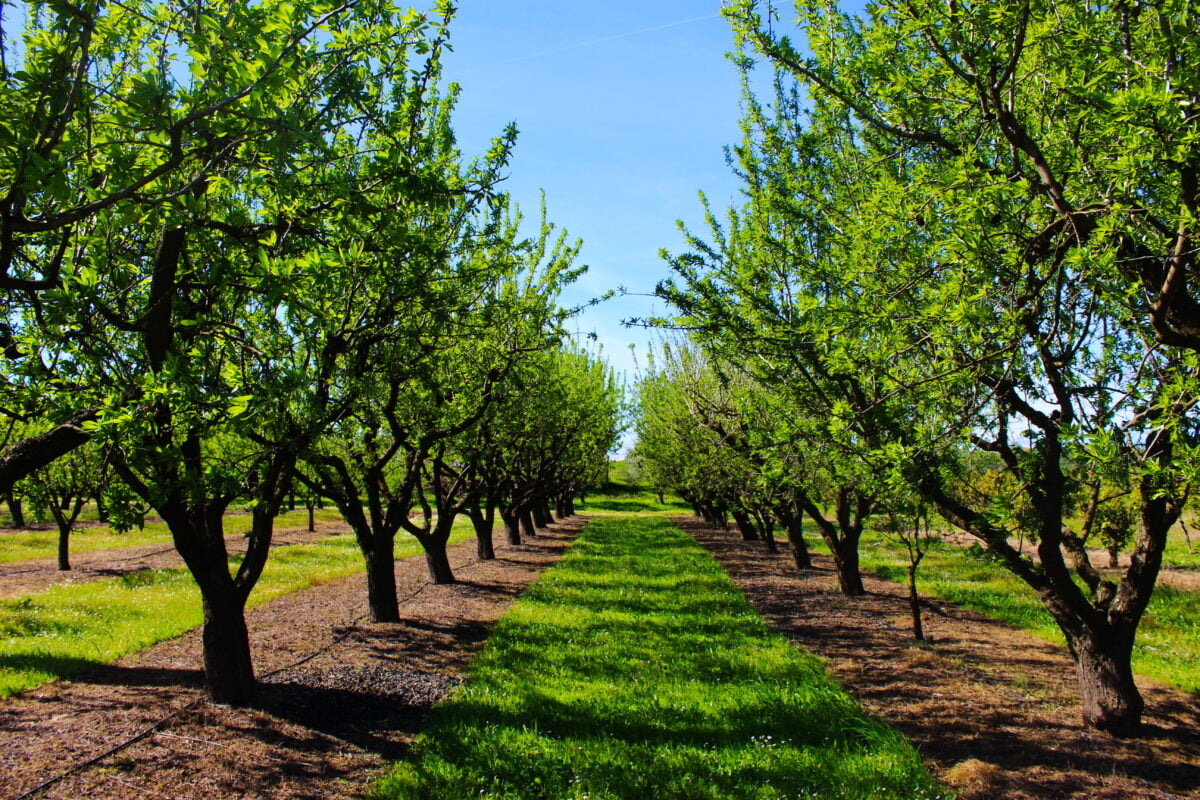Oat and almond milk are among the most popular plant-based milk alternatives. Brands like Oatly, Alpro, Rude Health, and Moma have become ubiquitous in supermarkets and coffee shops. The global oat milk market is worth more than USD $2 billion, while the almond milk market is worth double that at more than $5 billion.
Plant-based milks are popular for being more ethical and sustainable than dairy. Many people also choose plant-based milk for health reasons, such as wanting to cut down on saturated fat in their diet. But is oat milk or almond milk better for you health, the planet, and animals?
Is oat or almond milk healthier?
“There is not a simple answer to which is healthier in terms of almond or oat milk,” Emily McKee, Dietitian at the Vegan Society, tells Plant Based News. “Neither is ‘better’ or ‘worse’ than the other, and people have varying taste preferences and nutritional needs that may factor into their choice of alternative milk.”
The main difference between oat and almond milk is in their fiber and carbohydrate content. This varies between brands, so here we’ll compare the oat milk and the almond milk of one brand – Alpro.
Per 100ml, Alpro’s Original Oat Drink has 1.9g of fiber and 6.5g of carbohydrates. It’s Almond Original has 0.4g of fiber and 2.4g of carbs. Fiber is an important part of a healthy diet and our bodies need carbs for energy. So in this sense oat milk goes further towards meeting your daily energy needs. (Recent claims that the carb content of oat milk causes blood sugar spikes are unfounded)
“Some manufacturers have developed oat milk ranges that include ‘whole’, ‘semi’ and ‘skimmed’ varieties, offering flexibility of choice depending on your dietary needs,” McKee says. “Many people prefer to opt for lower calorie versions of dairy alternative drinks such as almond milks. However, if you have high nutritional needs, increased activity levels or a small appetite, higher calorie options such as ‘whole’ oat drinks can be a good way to increase your energy intake.”
Both oat and almond milk are low in fat and protein – Alpro’s versions contain both contain 0.4g of protein. Dietitians advise that if you want to get more protein through plant-based milk, soy or pea milk are the best options.
Both oat and almond milks are often fortified with calcium and vitamins including B12 and vitamin D. Almonds naturally contain vitamin E, which supports the health of you skin, eyes, and immune system.
Is oat or almond milk better for the environment?

Many people switch from dairy to plant-based milk in a bid to shrink their environmental footprint. When it comes to comparing oat and almond milk, both have a low environmental impact, but oat is slightly better overall.
Emissions
Oat and almond milk are among the lowest carbon options of plant-based milks. Each liter of oat milk emits around 0.9kg of carbon dioxide equivalents (CO2e). Almond milk is very slightly better, emitting 0.7kg of CO2e per liter.
Different companies have different calculations of their carbon footprints. Oatly says a liter of its Whole Oat Drink emits 0.49kg of CO2e, calculated using a Life Cycle Assessment through carbon data company Carbon Cloud.
Alpro doesn’t give the emissions of its milks, but says they emit 19 to 26 percent less carbon than dairy milk. Dairy milk typically produces 3.15kg of CO2e per liter.
The emissions associated with plant-based milks cover several stages of their production. These are growing the crops like oats or almonds, which includes emissions from the soils and energy used for powering farm equipment. Other emissions come from transporting ingredients and the final product to retailers, energy used in processing ingredients, and the manufacturing and transporting of packaging.
Land use
The difference between oat and almond milk when it comes to land use is almost as small as it is for emissions. Oat uses 0.76m2 of land per liter, while almond uses 0.5m2.
As well as how much land is used to grow the crops, where the crops are grown matters too. For example, people often worry that soy milk may help to drive deforestation in the Amazon. This isn’t actually the case, since most soy is grown as animal feed. As for oat and almond milk, neither is linked to deforestation.
If you are concerned about where crops are grown to make your oat or almond milk, this information is often available on the manufacturers’ websites. Alpro’s almonds and oats all come from European farms, for instance.
Pollution
Agriculture can cause different kinds of pollution including air and water pollution. When it comes to comparing plant-based milks, the data available measures their pollution of surroundings land and water, or eutrophication. Eutrophication is when excess nutrients such as nitrogen and phosphate from animal manure or fertilizers runoff from farms and pollute surrounding ecosystems.
Dairy milk involves much higher levels of eutrophication – 10.65g per liter – than plant-based milks due to the amount of manure generated by cows. Oat milk is responsible for 1.62g per liter, and almond 1.5g.
There may be a variety of fertilizers used in growing oats or almonds. Oatly, for example, says that its farmers have different practices in this regard. While some use mineral (synthetic) fertilizers, others use manure or bone meal. The type and amount of fertilizer used is what causes eutrophication associated with growing the crops for plant-based milk.
Water use
Water use is where oat milk definitely beats almond milk. Producing one liter of almond milk requires 371 liters of freshwater, while a liter of oat milk requires 48 liters. (Almond milk is still far less water intensive than dairy, which uses almost twice as much freshwater per liter.)
Some plant-based milk manufacturers may use more or less freshwater to make their products. To take Alpro as our example again, the company says two-thirds of the water used to grow its almonds comes from rain, rather than irrigation systems. It says that this means its almonds use eight times less water than those grown in America.
Is oat or almond milk more ethical?
All plant-based milks are considered ethical alternatives to dairy (the dairy industry is widely regarded as hugely cruel). But almond milk has developed a bit of a reputation for being bad for bees. This is because the almond orchards in California depend heavily on pollination by migratory beehives.
Migratory beekeeping is a way to compensate for dwindling numbers of native bees and other pollinating insects. It involves loading hives onto trucks and transporting them to specific sites to pollinate commercially grown crops.
The practice is particularly common in the US. According to Scientific America, 1,500 beekeepers with a combined 31 billion honeybees visit California’s 90 million almond trees each year. Frequent travel and confinement to trucks for hours, or sometimes days, at a time is thought to be stressful for the bees. A huge 30 percent of a keeper’s bees will die each year. That’s more bees than all other animals raised for slaughter in the US. This is due in part to high levels of pesticide use in California’s almond orchards.
While California produces 80 percent of the world’s almonds, you can still avoid buying almond milk made with Californian almonds. Brands that source almonds from Europe may be a more ethical choice. Alpro, for instance, says that it is working to help its farmers make their almond orchards more wildlife friendly.
More ethical than dairy
Whether you choose oat or almond milk, neither requires inherently unethical practices like dairy milk does.
Dairy cannot be produced at scale without the forcibly impregnation of cows, and the subsequent separation of them from their calves. Industrial milk production forces cows to stand for many hours on conrete floors, contributing to the lameness that affects a third of the UK’s dairy cows. Male calves in many countries are shot shortly after birth or exported via gruelling journeys to be turned into veal.
Is oat or almond milk better in coffee?

Almond milk has a distinctive nutty, slightly bitter flavor which can overpower some coffees. It is often fairly thin in texture and can separate after steaming, but it creates a pleasingly silky foam.
Oat milk is popular in coffee shops for a reason. With its creamy texture and mild flavor, it blends well perfectly with coffee and froths well too. The taste of oat milk can also be easier to adapt to than nut or legume-based options for people trying plant-based milk for the first time.
More like this:
"oat" - Google News
March 09, 2024 at 07:00PM
https://ift.tt/ZvU2u8q
Oat Milk Vs Almond Milk: Which Is Best? - Plant Based News
"oat" - Google News
https://ift.tt/1j3QKL7
https://ift.tt/7tpwUhB
Bagikan Berita Ini














0 Response to "Oat Milk Vs Almond Milk: Which Is Best? - Plant Based News"
Post a Comment